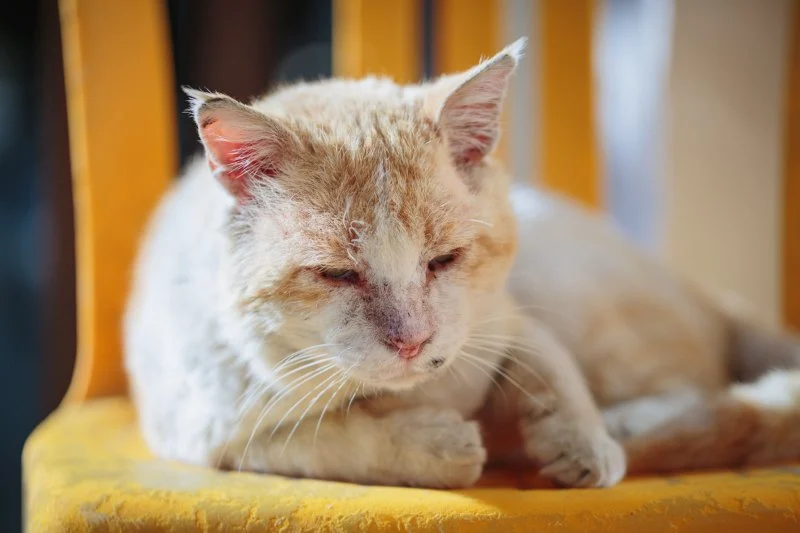
1. Introduction: Understanding Feline Cancer
As cat owners, one of the most heartbreaking concerns we face is the possibility of our feline companions developing cancer. Like humans, cats can suffer from various types of cancer, and it can sometimes be difficult to detect in the early stages. Feline cancer is not uncommon, and it affects cats of all breeds and ages, though older cats tend to be more prone to certain types.
In this article, we will explore the most common types of feline cancer, the symptoms to watch for, and how you can help your cat receive the proper care. Early detection and treatment are key, so understanding the signs of cancer in cats can make a huge difference in their prognosis.

Bethel Village Square Animal Hospital
BethelWestern Connecticut Planning RegionConnecticut
10-A Elizabeth St, Bethel, CT 06801, USA
2. Common Types of Feline Cancer
Feline cancer can develop in various parts of the body, including the organs, blood, skin, and bones. There are several types of cancer that are more common in cats, each with distinct characteristics and symptoms. Here are the most frequently diagnosed cancers in cats:

Ridgecrest Animal Hospital
AllentownMonmouth CountyNew Jersey
12 Allyson Way, Allentown, NJ 08501, USA
2.1. Lymphoma
Lymphoma is one of the most common types of cancer in cats. It affects the lymphatic system, which is part of the immune system. Lymphoma can occur in various organs, including the lymph nodes, spleen, intestines, and even the skin. It is often seen in older cats and can present itself in several ways, depending on the affected organs.
Symptoms of lymphoma in cats can include weight loss, lethargy, loss of appetite, vomiting, diarrhea, and enlarged lymph nodes. Early detection can lead to more effective treatment, which often includes chemotherapy.
2.2. Squamous Cell Carcinoma (SCC)
Squamous Cell Carcinoma (SCC) is a type of skin cancer that affects the squamous cells in the skin, mouth, and other mucous membranes. It is particularly common in outdoor cats that have exposure to sunlight, as UV radiation can damage the cells. This type of cancer is often seen in the face, ears, and nose.
Common signs of SCC in cats include sores or ulcers that do not heal, swelling in the affected area, bleeding from the mouth or nose, and loss of appetite. If untreated, SCC can spread to other parts of the body, making early detection crucial.
2.3. Mammary Gland Tumors
Female cats, especially those that have not been spayed, are at a higher risk of developing mammary gland tumors, a form of breast cancer. These tumors can be benign or malignant, but malignant tumors can spread to other parts of the body.
Symptoms of mammary gland tumors in cats include the appearance of lumps or swelling in the mammary area, changes in appetite, weight loss, or lethargy. Spaying your cat at an early age can reduce the risk of these tumors significantly.
2.4. Osteosarcoma
Osteosarcoma is a type of bone cancer that is most commonly diagnosed in older cats. This cancer typically affects the limbs and can cause severe pain and lameness. Osteosarcoma is aggressive and can spread to other parts of the body, including the lungs.
Signs of osteosarcoma in cats include lameness, swelling, difficulty moving, and visible pain when the affected limb is touched. If you notice your cat limping or acting unusually stiff, a vet visit is crucial for diagnosing the condition.
3. Symptoms of Cancer in Cats: What to Look For
Recognizing the signs of cancer in cats early on can help in timely diagnosis and treatment. While some of the symptoms of feline cancer can overlap with other conditions, it’s important to stay alert for changes in your cat's behavior or physical appearance. Here are some common symptoms that may indicate cancer in cats:
3.1. Changes in Appetite and Weight Loss
A noticeable change in your cat’s appetite—whether they are eating significantly less or more—can be a warning sign of illness, including cancer. Weight loss, despite an unchanged diet, is also a red flag. If your cat’s weight seems to fluctuate without a clear cause, it’s essential to consult your veterinarian.
3.2. Lethargy and Decreased Activity
Cats with cancer often become more lethargic and spend much of their time resting. If your normally active cat becomes unusually tired or disinterested in play, it could be a sign of underlying health issues.
3.3. Vomiting or Diarrhea
Frequent vomiting or diarrhea, especially if it’s accompanied by other symptoms like weight loss or lack of appetite, may indicate gastrointestinal cancer or other forms of cancer affecting the digestive system.
3.4. Abnormal Lumps or Swellings
One of the most common signs of cancer in cats is the appearance of lumps or swelling under the skin. These lumps may be found in the lymph nodes, mammary glands, or other areas. It’s important to get any unusual lumps checked by a vet to rule out cancer or other potential health issues.
3.5. Difficulty Breathing or Coughing
If your cat starts coughing, wheezing, or has trouble breathing, it could be a sign of lung cancer or metastasis (spread of cancer from another part of the body). This is especially concerning if it persists over time and is accompanied by other symptoms like weight loss or lethargy.
4. How Cancer Is Diagnosed in Cats
Diagnosing cancer in cats can involve a combination of physical exams, blood tests, imaging (like X-rays or ultrasounds), and biopsies. Your veterinarian may also recommend specialized tests to determine the type of cancer and its stage. Early diagnosis is critical in managing cancer and giving your cat the best chance of recovery or managing symptoms.
4.1. Physical Examination and History
Your vet will begin by performing a thorough physical examination to check for lumps, abnormalities, or signs of illness. They will also ask about your cat’s medical history and any changes in behavior or health that you’ve observed.
4.2. Blood Tests and Imaging
Blood tests can help assess your cat’s overall health and detect signs of cancer-related issues, such as anemia or organ dysfunction. Imaging, such as X-rays, ultrasounds, or CT scans, can help identify tumors, metastasis, and organ involvement.
4.3. Biopsy and Laboratory Testing
If a tumor or abnormality is found, a biopsy is often performed to determine whether it is cancerous. The sample is sent to a lab for analysis, and the results can help guide treatment options and determine the type of cancer.
5. Treatment Options for Feline Cancer
Treatment for feline cancer depends on the type, location, and stage of cancer. Options may include surgery, chemotherapy, radiation therapy, or palliative care. Your veterinarian will discuss the best treatment plan based on your cat’s specific diagnosis.
5.1. Surgery
Surgery may be recommended to remove tumors or affected tissue. This is typically done if the cancer is localized and can be removed safely. In some cases, surgery may be combined with other treatments like chemotherapy to prevent recurrence.
5.2. Chemotherapy
Chemotherapy is often used to treat cancers like lymphoma. While chemotherapy can have side effects, it may be the most effective way to control the spread of cancer and improve your cat’s quality of life.
5.3. Radiation Therapy
Radiation therapy is another option for cats with localized tumors. It targets cancer cells while minimizing damage to healthy tissue. Radiation may be used in combination with surgery or chemotherapy for more comprehensive treatment.
6. Conclusion: Caring for a Cat with Cancer
Caring for a cat diagnosed with cancer can be emotional and challenging, but with the right treatment and support, many cats continue to live happy, fulfilling lives. Early detection, proper treatment, and regular follow-up care are critical for managing the disease and improving your cat’s prognosis.
If you're concerned about your cat’s health or need help managing their treatment, visit Omnia Pet for the best products, services, and resources to help support your feline friend through their journey to recovery.







 East Los Angeles Dog and Cat Hospital4.0 (319 reviews)
East Los Angeles Dog and Cat Hospital4.0 (319 reviews) VIP Petcare Vaccination Clinic0.0 (0 reviews)
VIP Petcare Vaccination Clinic0.0 (0 reviews) Puppies N Love4.0 (797 reviews)
Puppies N Love4.0 (797 reviews) Cochise Animal Hospital4.0 (360 reviews)
Cochise Animal Hospital4.0 (360 reviews) VCA Southern Tier Animal Hospital4.0 (159 reviews)
VCA Southern Tier Animal Hospital4.0 (159 reviews) Koran Tropical Fish3.0 (64 reviews)
Koran Tropical Fish3.0 (64 reviews) Why Do Kittens Like to Sleep in Sunbeams? Discover the Benefits of Sunbathing
Why Do Kittens Like to Sleep in Sunbeams? Discover the Benefits of Sunbathing Everything You Need to Know About Spaying and Neutering Your Pet
Everything You Need to Know About Spaying and Neutering Your Pet The Best Cat Carriers for Stress-Free Vet Visits | Omnia Pet
The Best Cat Carriers for Stress-Free Vet Visits | Omnia Pet Why Do Kittens Like to Play in Empty Boxes? Uncover the Fun and Fascination
Why Do Kittens Like to Play in Empty Boxes? Uncover the Fun and Fascination How to Tell if Your Kitten is Part Wildcat – Signs and Characteristics to Look For
How to Tell if Your Kitten is Part Wildcat – Signs and Characteristics to Look For Signs of Bloat in Dogs (GDV): This is a Life-Threatening Emergency
Signs of Bloat in Dogs (GDV): This is a Life-Threatening Emergency